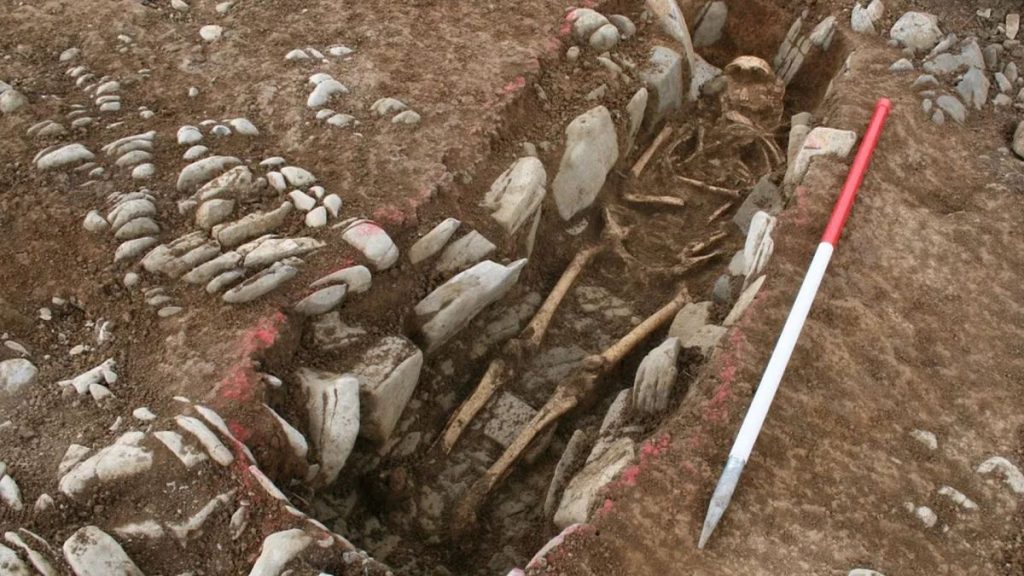In a remarkable archaeological discovery near Cardiff Airport in Wales, researchers have unearthed a site dating back to the 6th or 7th century. The excavation has revealed a burial ground containing 39 skeletons, predominantly of women, alongside various intriguing artefacts that hint at both their roles and status in the society of the time. Notably, the findings have raised questions about social hierarchies and the lived experiences of women in that era, particularly given the evidence of manual labor and wealth found in their remains.
| Article Subheadings |
|---|
| 1) Discovery of the Site |
| 2) The Skeletons and Their Significance |
| 3) Artefacts Unearthed |
| 4) Unique Burials and Anomalies |
| 5) Broader Implications of the Find |
Discovery of the Site
Last year, archaeologists made a significant discovery near Cardiff Airport in Wales, which has since been the focus of research and excavation efforts. Located in a field at Fonmon Castle, the site has revealed a burial ground containing 39 adult skeletons. The excavation began after initial findings sparked interest, raising questions about the historical context of the site. Excavation has continued into the current year, revealing further details that could contribute to a deeper understanding of the community that once inhabited this area.
The Skeletons and Their Significance
Among the 39 skeletons unearthed, the majority were women, with only one male skeleton identified. This demographic finding has led researchers to question the social structure and roles of women in this time period. Most of the women’s bones showed signs of manual labor, suggesting that they had significant daily responsibilities, unlike the traditionally passive roles often attributed to women in historical narratives. Additionally, evidence of wealth, such as luxurious burial items, points towards a society where status and gender intersected in complex ways.
Artefacts Unearthed
In conjunction with the skeletons, researchers uncovered an array of artefacts that offer insights into the lifestyle and socio-economic conditions of the time. Shards of pottery and fine etched glass were among the items found, with the glass believed to have been imported from regions such as the Levant and Southern France. The discovery of such upscale items suggests that the individuals buried at the site belonged to a community of considerable status. This finding can alter the perception of trade and interactions between distant cultures during the 6th or 7th century in Britain.
Unique Burials and Anomalies
A particularly striking aspect of the burial practices observed at the site is the care taken in the interment of the individuals. Most skeletons were positioned flat or crouched, facing east to west, indicative of respectful burial customs prevalent in many ancient cultures. However, one skeleton—a woman found tossed into a ditch—contrasts sharply with this trend. This peculiar burial raises questions about her identity. Researchers hypothesize that she may have been an outcast or a criminal, highlighting the potential stigma and social penalties that individuals could have faced in this society as indicated by the hygiene of burial practices. Further lab analysis at Cardiff University will help ascertain more about her life and the reasons for her unusual burial.
Broader Implications of the Find
The remarkable findings from this burial site not only contribute to the understanding of early medieval communities in Wales, but they also illuminate the broader social fabric of the time. According to Dr. Andy Seaman of Cardiff University, who is leading the research, “We’re hoping to tell the story of the individuals within the cemetery, but also the broader community.” This aspiration reflects a shift in archaeological focus towards illuminating the lives of common people rather than exclusively those of elites. Additionally, as researchers investigate the connections and relationships between individuals unearthed at the site, they hope to uncover the intersection of social roles, cultural practices, and community dynamics during a period that has often been overlooked in historical studies.
| No. | Key Points |
|---|---|
| 1 | Archaeologists discovered a burial site near Cardiff Airport, dated to the 6th or 7th century. |
| 2 | The majority of skeletons unearthed are female, with evidence of wealth and manual labor. |
| 3 | Artefacts include imported glass and pottery, indicating social status. |
| 4 | Burial practices reveal care in interment, with one anomaly raising questions about social stigma. |
| 5 | Research aims to elucidate the life experiences of common people and their roles within the community. |
Summary
The excavation of a burial site near Cardiff Airport not only reveals the complex social fabric of a 6th or 7th-century community but also provides a unique window into the lives of its women. The findings challenge assumptions about gender roles, wealth, and burial practices from a time that is often shrouded in historical obscurity. Continued research may shed further light on this intriguing period, enriching our understanding of early medieval life and cultural interactions in Britain.
Frequently Asked Questions
Question: What is the historical significance of the burial site near Cardiff Airport?
The site is significant as it provides insights into the social and cultural practices of a community from the 6th or 7th century, particularly highlighting the roles of women in society.
Question: What unusual findings were made during the excavation?
Apart from the majority female skeletons, a particularly striking finding was a woman buried carelessly in a ditch, which may suggest social stigma or punishment, contrasting sharply with the careful burials of others in the site.
Question: What kind of artefacts were discovered at the site, and what do they indicate?
Artefacts such as shards of fine etched glass and pottery suggest that those buried at the site belonged to a community of considerable status, engaging in trade with distant regions like the Levant and Southern France.


